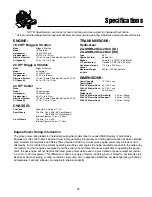
33
Specifications
ENGINE:
18.5 HP* Briggs & Stratton
Make
Briggs & Stratton
Model
18.5 hp Intek
Horsepower
18.5 @ 3400 rpm
Displacement
30.59 Cu. in (501 cc)
Electrical System
12 Volt, 16 amp. Alternator, Battery: 230 CCA
Oil Capacity
52 oz. ( 1.5L) w/ Filter
20 HP* Briggs & Stratton
Make
Briggs & Stratton
Model
20 hp Intek
Horsepower
20 @ 3500 rpm
Displacement
40.0 Cu. in (656 cc)
Electrical System
12 Volt, 16 amp. Alternator, Battery: 230 CCA
Oil Capacity
64 Oz. (1.9 L) w/ Filter
20 HP* Kohler
Make
Kohler
Model
20 hp Courage
Horsepower
20 @ 3600 rpm
Displacement
36.4 Cu. in (597 cc)
Electrical System
12 Volt, 15 amp. Alternator, Battery: 230 CCA
Oil Capacity
51 Oz. ( 1.5L) w/ Filter
CHASSIS:
Fuel Tank
Capacity: 3.0 Gallons (11.4 L)
Rear Wheels
Tire Size: 18 x 6.50-8 (38” Deck Models)
18 x 8.50-8 (42” Deck Models)
Inflation Pressure: 15 psi (1,03 bar)
Front Wheels
Tire Size: 11 x 4.00-5
Inflation Pressure: 25 psi (1,72 bar)
TRANSMISSIONS:
Hydro-Gear
ZA-DHBB-2D5A-2DCX (LH)
ZA-AHBB-2D5A-2DCX (RH)
Type
EZT
Hydraulic Fluid
Sealed Unit
Speeds
Forward: 0-6.2 MPH (0-9.98 km/h)
@ Specified rpm
Reverse: 0-3 MPH (0-4.83 km/h)
Continuous Torque
115 ft. lbs. (155 N.m.)
Output
Maximum Weight
340 lbs. (154 Kg) per Axle
on Axle
DIMENSIONS:
Overall Length
72” (182,9 cm)
Overall Width
With 38” Mower Deck
49” (124,5 cm)
With 42” Mower Deck
52” (132,1 cm)
Height
38” (96,5 cm)
Weight (apx.)
With 38” Mower Deck (Simplicity)
520 lbs. (236 kg)
With 38” Mower Deck (Snapper)
500 lbs. (227 kg)
With 42” Mower Deck
540 lbs. (245 kg)
NOTE: Specifications are correct at time of printing and are subject to change without notice.
* Actual sustained equipment horsepower will likely be lower due to operating limitations and environmental factors.
Engine Power Rating Information
The gross power rating labels for individual gas engine models meet or exceed SAE (Society of Automotive
Engineers) code J1940 (Small Engine Power & Torque Rating Procedure) and rating performance has been obtained
and corrected in accordance with SAE J1995 (Revision 2002-05). Actual gross engine power may be lower and is
affected by, but not limited to, ambient operating conditions and engine to engine variability. Given both the wide array
of products on which engines are placed, and the variety of environmental issues applicable to operating the equip-
ment, the gas engine will not develop the rated gross power when used in a given piece of power equipment (actual
“on-site” or net horsepower). This difference is due to a variety of factors including, but not limited to, accessories (air
cleaner, exhaust, charging, cooling, carburetor, fuel pump, etc.), application limitations, ambient operating conditions
(temperature, humidity, altitude), and engine to engine variability.



































